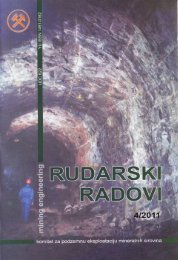Institut za rudarstvo i metalurgiju Bor
Institut za rudarstvo i metalurgiju Bor
Institut za rudarstvo i metalurgiju Bor
You also want an ePaper? Increase the reach of your titles
YUMPU automatically turns print PDFs into web optimized ePapers that Google loves.
leaching reagents in the gold mining because<br />
of its high gold and silver recoveries<br />
and relatively low costs of process [1].<br />
And today, over 100 years later [2],<br />
gold and silver are recovered using the<br />
cyanide simple reactions 1 and 2:<br />
4Au+8NaCN+O2+2H2O=<br />
=4Na[Au(CN)2] +4NaOH..............(1)<br />
4Ag+8NaCN+O2+2H2O=<br />
=4Na[Ag(CN)2] +4NaOH.............(2)<br />
Most cyanide leaching is carried out at<br />
an alkaline pH between 10 and 11, depending<br />
on individual concentrate characteristics<br />
[3].<br />
Concentration of cyanide solution is<br />
also important in the leaching process with<br />
concentration of NaCN ranging from<br />
0.02% to 0.15%. Concentration of sodium<br />
cyanide depends on precious metals content<br />
and other ingredients, first of all copper<br />
in sulphide concentrate.<br />
Oxidant [4], first of all oxygen, has<br />
also an important role in the leaching<br />
process of precious metals in cyanide solution.<br />
It has been proven that the dissolution<br />
rate of precious metals in cyanide<br />
solution is directly proportional to the<br />
amount of present oxygen.<br />
Mineralogical identification of concentrate<br />
is used for defining the technological<br />
flow sheet for concentrate [5]. Some alternative<br />
leaching agents, namely thiourea,<br />
have been tried due to the environmental<br />
concerns, generally without economic success<br />
[6].<br />
EXPERIMENTS<br />
Characteri<strong>za</strong>tion of Raw Materials and<br />
Treatment Methods<br />
Investigations were carried out on sulphide<br />
concentrate samples from the mine<br />
"RUDNIK". Chemical analysis of concentrate<br />
is given in Table 1.<br />
Table 1. Chemical analysis of concentrate<br />
Element Content, %<br />
Cu 18.04<br />
Fe 24.51<br />
Pb 7.45<br />
Zn 12.04<br />
Bi 0.47<br />
Ag (g/t) 895<br />
According to the carried out X-ray –<br />
structural analysis, the stage content of<br />
concentrate is the following: ZnS, FeS2,<br />
SiO2, PbS, CuFeS2.<br />
For separation of non-ferrous and precious<br />
metals from concentrate, the following<br />
technological methods were used:<br />
• Low temperature sulphati<strong>za</strong>tion for<br />
the aim of transfer the sulphide forms<br />
of metal into oxide forms<br />
• Leaching of sulphati<strong>za</strong>tion products<br />
with water for the aim of copper, iron<br />
and zinc transfer into solution<br />
• Cyanide leaching of Ag from<br />
sulphati<strong>za</strong>tion product after the<br />
recovery of non-ferrous metals.<br />
• Thiourea leaching of Ag from<br />
untreated concentrate.<br />
Investigations were carried out with<br />
100 g of concentrate per experiment. Tube<br />
furnace for annealing was used in investigation<br />
as well as the glass laboratory reactor<br />
with heating lining and stirrer and<br />
heater with automatic temperature regulation,<br />
holes for charging and oxygen supply,<br />
and the other necessary laboratory<br />
equipment.<br />
RESULTS AND DISCUSSION<br />
Low Temperature Sulphati<strong>za</strong>tion Process<br />
Low temperature sulphati<strong>za</strong>tion process<br />
was carried out with the concentrated<br />
sulphuric acid. By leaching with water,<br />
after sulphati<strong>za</strong>tion, the following leaching<br />
degree was realized (Table 2):<br />
No 1,2010. 86<br />
MINING ENGINEERING



